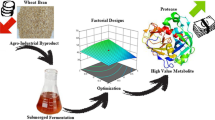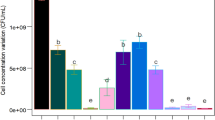Abstract
One of the limiting factors to the effectiveness of biostimulation and bioremediation is the loss of inoculated material from the site. This can occur by a number of pathways, but is particularly problematic in open water systems where the inoculated material is simply lost in the water. It is desirable to develop new material, a matrix, within which bacteria and/or biostimulants can be incorporated.
We have investigated the basic physical properties of insoluble potato starch to eventually evaluate its use as such a matrix. Insoluble starch fibers were prepared from white potato (Solanum tuberosum) and sweet potato (Ipomoea batatas) and were compared for their melting temperature by DSC and their ability to bind/aggregate bacteria. The DSC curves for white and sweet potato showed that the melting temperature is 127.34 and 133.05°C for white and sweet potato fibers, respectively. The TG curves for white and sweet potato starches exhibited one main mass loss step corresponding to the DTG peak temperature at 323.39 and 346.93°C, respectively. The two types of fibers, however, showed different binding/aggregation capacities for bacteria, with white potato approximately twice as many cells of Burkholderia cepacia (22.6 billion/g) as cells of Pseudomonas putida. The reverse was true for fibers from sweet potato, binding twice as many cells of Pseudomonas putida (23 billion/g) as cells of Burkholderia cepacia.
Similar content being viewed by others
References
K. Watanabe, Curr. Opin. Biotechnol., 12 (2001) 237.
E. Kerry, Polar Biol., 13 (1993) 163.
P. Fernández-Álvarez, J. Vila, J. M. Garrido-Fernández, M. Grifoll and J. M. Lema, J. Hazard. Mater., 137 (2006) 1523.
P. U. M. Raghavan and M. Vivekanandan, Int. Biodeterior. Biodegrad., 44 (1999) 29.
C. O. Obuekwe and E. M. Al-Muttawa, Biotechnol. Lett., 23 (2001) 1025.
W. E. Levinson, K. E. Stormo, H. Tao and R. L. Crawford, Biological Degradation and Bioremediation of Toxic Chemicals, (1994) 455.
R. N. Z. Rahman, F. M. Ghazali, A. B. Salleh and M. Basri, J. Microbiol, 44 (2006) 354.
H. Minato and T. Suto, J. Gen. Appl. Microbiol., 22 (1976) 259.
T. Ferenci, Biotechnol. Bioeng., 38 (1991) 314.
S. U. Nwachukwu, Curr. Microbiol., 42 (2001) 231.
B. R. Folsom, P. J. Chapman and P. H. Pritchard, Appl. Environ. Microbiol., 56 (1990) 1279.
P. P. Luu, C. W. Yung, A. K. Sun and T. K. Wood, Appl. Microbiol. Biotechnol., 44 (1995) 259.
S. C. Mojumdar, G. Madhurambal and M. T. Saleh, J. Therm. Anal. Cal., 81 (2005) 205.
S. C. Mojumdar, K. G. Varshney and A. Agrawal, Res. J. Chem. Environ., 10 (2006) 89.
S. C. Mojumdar, E. Jóna and M. Melnik, J. Therm. Anal. Cal., 60 (2000) 571.
H. S. Rathore, G. Varshney, S. C. Mojumdar and M. T. Saleh, J. Therm. Anal. Cal., in press.
S. C. Mojumdar, J. Therm. Anal. Cal., 64 (2001) 1133.
P. Simon, E. Illekova and S. C. Mojumdar, J. Therm. Anal. Cal., 83 (2006) 67.
K. G. Varshney, V. Jain, A. Agrawal and S. C. Mojumdar, J. Therm. Anal. Cal., 86 (2006) 609.
S. C. Mojumdar, J. Therm. Anal. Cal., 64 (2001) 629.
G. Madhurambal, P. Ramasamy, P. A. Srinivasan and S. C. Mojumdar, J. Therm. Anal. Cal., 86 (2006) 601.
S. C. Mojumdar, L. Martiška, D. Valigura and M. Melník, J. Therm. Anal. Cal., 81 (2005) 243.
S. C. Mojumdar, J. Kozankova, J. Chocholusek, J. Majling and V. Nemecek, J. Therm. Anal. Cal., 78 (2004) 73.
S. C. Mojumdar, J. Kozánková, J. Chocholoušek, J. Majling and D. Fábryová, J. Therm. Anal. Cal., 78 (2004) 145.
J. Kozánková, S. C. Mojumdar, J. Chocholoušek, J. Kákoš, M. Balog and L. Krajčová, J. Therm. Anal. Cal., 81 (2005) 191.
R. A. Porob, S. Z. Khan, S. C. Mojumdar and V. M. S. Verenkar, J. Therm. Anal. Cal., 86 (2006) 605.
R. Crittenden, A. Laitila and P. Forssell, J. Matto, M. Saarela, T. Mattila-Sandholm and P. Myllarinen, Appl. Environ. Microbiol., 67 (2001) 3469.
H. Minato and T. Suto, J. Gen. Appl. Microbiol., 24 (1978) 1.
Author information
Authors and Affiliations
Corresponding author
Rights and permissions
About this article
Cite this article
Elliott, C., Ye, Z., Mojumdar, S.C. et al. A potential bacterial carrier for bioremediation. J Therm Anal Calorim 90, 707–711 (2007). https://doi.org/10.1007/s10973-007-8526-5
Published:
Issue Date:
DOI: https://doi.org/10.1007/s10973-007-8526-5




